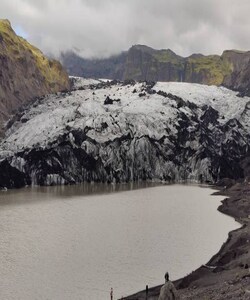
Majority of Himalayan glaciers analysed are melting or retreating at varying rates: Govt to Parliamentary panel
Majority of Himalayan glaciers analysed are melting or retreating at varying rates in different regions, the government has said.
It has noted that melting glaciers due to any impact of climate change will not only severely affect the flow in Himalayan river system but will also give rise to natural disasters.
The government’s response was given to a parliamentary standing committee looking at Glacier Management in the Country – Monitoring of Glaciers/Lakes, including Glacial Lake Outbursts, leading to Flash-floods in the Himalayan Region.
The parliamentary standing committee report was tabled in Lok Sabha on Wednesday.
Explaining the problem of incessant melting and retreating of Himalayan glaciers and the estimated volume loss of glaciers between the year(s), the Department of Water Resources, River Development and Ganga Rejuvenation said the Geological Survey of India has conducted studies on their melting by assessment of mass balance studies on nine glaciers and also carried out monitoring the recession or advancement of 76 glaciers.
“Majority of Himalayan glaciers are observed melting/ retreating at varying rates in different regions,” it said.
The department pointed out that melting glaciers due to any impact of climate change will not only severely affect the flow in Himalayan river system but will also give rise to disasters like Glacier Lake Outburst Flood (GLOF), glacier avalanche, landslide etc.
Asked about the other adverse consequences of melting glaciers, especially on the ecology of the Himalayas, the department said melting of glaciers may lead to shift of tree line in the Himalaya and may also cause change in phonological behaviour of plants.
“It may impact the livelihoods of mountain people and downstream populations. Such changes may lead to negative impact on biodiversity conservation and ecosystem services of the Himalaya,” it said. The parliamentary standing committee flagged the lack of data sharing on hydrological information with the neighbouring countries.
The Committee noted that there is no specific agreement or treaty with neighbouring countries for sharing of glacier-related data for large-scale modelling and runoff evolution.
The Committee said it is of the view that in order to devise a comprehensive and coordinated strategy that could effectively address both the risk of glacier-related outburst floods and water management challenges, regional cooperation is the need of the hour.
“Since the threat posed by the melting/retreating Himalayan glaciers transcends the national boundaries of the Himalayan nations, the Committee is of the considered view that in order to formulate an effective and comprehensive response to the threat posed by melting of glaciers and for mitigating potential hazard situations, regional cooperation for seamless sharing of hydrological information / data on glacier movement / behaviour is very much warranted,” it said.
The Committee, therefore recommended to the Department of Water Resources, River Development and Ganga Rejuvenation to take up the matter with the Ministry of External Affairs to have some kind of bilateral or multilateral agreement with neighbouring Himalayan countries for sharing of information and data on the changing state of glaciers and the threats posed by them.
Asked about the veracity of the fact that over the past 50 years, the Himalayas have become less cold with substantiated decline in number of extreme cold days and cold nights due to global warming and climate change, the department said as per information given by the Environment ministry the climate change studies exclusively over the Himalayas reported a consistent warming in the present climate.
Trend analysis of cold days and cold nights of 16 stations across J&K and Himachal Pradesh has revealed that for most of the stations, percentage number of warm days is increasing and number of cold days is decreasing.
Also, similar pattern of increase /decrease in percentage number of warm /cold nights is seen. The reduction of cold days is noted to be approximately two to six per cent within a 30-year period.

